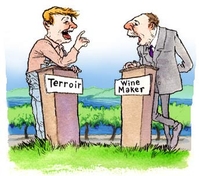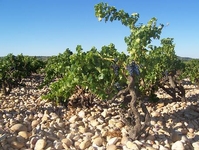In life there are some things that remain a mystery, no matter how hard you work to sort them out. Terroir is a prime example. Terroir as a concept is not that mysterious, though there are numerous definitions. What’s a mystery is how difficult it is to describe and tie a specific terroir to an individual wine or even a group of wines.
specific terroir to an individual wine or even a group of wines.
The thought of identifying terroir in a specific wine has been nagging at me after tasting thousands of wines over many years. Then I read a quote about Riesling in the “Wine Grape Press,” an online newsletter posted by the New York Winegrape Foundation. Writing in his “Vintage Experiences” newsletter, wine writer Dan Berger, an avid Riesling fan (and who isn’t?) had this to say about Finger Lakes Rieslings and terroir: “Dozens of (Finger Lakes) wineries consistently make a Riesling that, whether dry, sweet or in between, is exemplary in displaying Rieslingness within the framework of the sub-regional subtleties.” Nowhere did I read anything about “terroir” (and what is “Rieslingness”?) or words that tie the character and taste of Riesling to a specific Finger Lakes terroir, whatever that might be.
My intention is not to take Dan Berger to task over the terroir issue. He is a passionate wine lover and has done admirable work in promoting the pleasures of Riesling wines. And it’s not that I’m a terroir scoffer, since employing my elementary knowledge of geology, I know there are many different soil types that must have some influence on the rooted vines. The problem for me is that I can’t, with any certainty, say that the characteristics of a specific wine are identifiable because of the terroir in which the vines were grown. In an effort to describe wines we throw around terms like “mineral” and “earthy” and while they may be sound descriptors, do they mark a specific terroir? I ask because many of these handy wine descriptors can also be applied to other terroirs throughout the world.
A number of years ago, then California winery owner Bill Jekel had an on-going disagreement with Bordeaux chateau owner Bruno Prats that simmered at many levels but mainly regarding whether grapes and vineyards (read terroir) or winemaking was more important to the quality and character of a wine. As you might guess, Jekel was on the side of winemaking, while Prats, a true French vintner, argued for terroir. Today, winemaking is as important as ever, but winemakers worldwide now recognize the prime importance of a vineyard’s location and environment which, I suppose, in an abstract way translates to terroir. Maybe, but what is it in a Bordeaux Cabernet that says it is from Bordeaux and not another region? And how much does winemaking, no matter how unobtrusive, mask terroir or the regionality of a wine?
The level of influence from winemaking comes up every year when a California-based wine industry magazine conducts an annual wine  competition that attempts both to award wines with medals but also identify each awarded wine against a specific terroir. I’ve been a judge at this competition a few times, but have never successfully been able to pin down a specific terroir in a wine, much less put the description of that terroir in words that made any sense, a frustrating task that was shared by many of my fellow judges. The main problem was that winemaking got in the way, overshadowing any characteristics of terroir that may have been present in the wine. This is especially true with most current Chardonnay, where oak used in fermentation and maturation is the dominant component.
competition that attempts both to award wines with medals but also identify each awarded wine against a specific terroir. I’ve been a judge at this competition a few times, but have never successfully been able to pin down a specific terroir in a wine, much less put the description of that terroir in words that made any sense, a frustrating task that was shared by many of my fellow judges. The main problem was that winemaking got in the way, overshadowing any characteristics of terroir that may have been present in the wine. This is especially true with most current Chardonnay, where oak used in fermentation and maturation is the dominant component.
Dan Berger is right about Finger Lake Rieslings, although we rarely see them on the Left Coast, but I still wonder precisely what it is that would set these apart from a Riesling from Australia’s Claire Valley, or even a dry Alsatian Riesling? I guess it will just remain a mystery.
* * *
Comments? E-mail me at [email protected]
6
